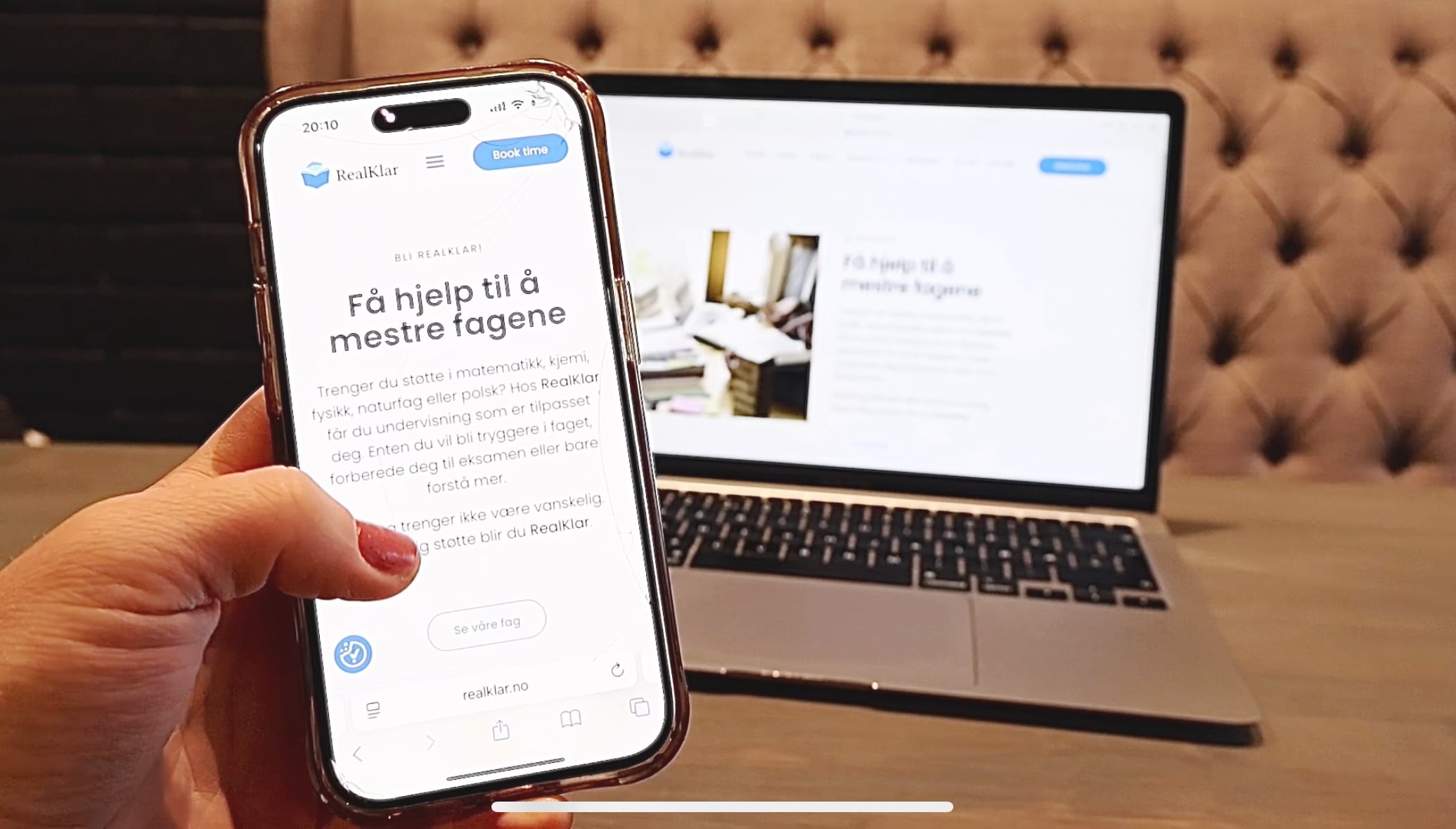The use of artificial intelligence (AI) in the healthcare sector has increased significantly in recent years, particularly in the transcription of doctor-patient conversations and the generation of medical records. Several Norwegian vendors offer similar AI-based solutions to streamline documentation processes. In this article, we compare three such providers: MediVox, Noteless and Medbric.
The aim is to provide healthcare professionals with a detailed and up-to-date overview of available alternatives, in line with the Directorate of Health's guidance on quality assurance when using AI in healthcare. The comparison focuses on functionality, security, privacy, price structure and regulatory requirements.
The article is continuously updated to ensure that the information is relevant and accurate. The suppliers mentioned have been informed about the comparison and have been given the opportunity to contribute with updated information.
1. Functionality
AI-based transcription services for healthcare professionals have two primary purposes:
- Automated transcription: The system listens to the conversation between doctor and patient and converts the speech into text in real time or after the consultation.
- Generation of structured journal notes: KI helps to reformulate the transcript into a more readable and medically correct journal text.
Comparison of features
| Function | MediVox | Noteless | Medbric |
|---|---|---|---|
| Transcription of doctor-patient conversations | ✅ | ✅ | ✅ |
| Automatic journal note generation | ✅ | ✅ | ✅ |
| Speech difference (doctor vs. patient) | ✅ | ❓ | ❓ |
| Meeting minutes | ✅ | ✅Dictation | ✅ |
| Personalization of journal notes | ✅ | ✅Fraser | ❓ |
| Use of generative AI (LLM) | Open AI (with ZDR), Mistral and others. | ❓ | Does not specify in its data processing agreement |
Brand: Not all information about specific features is publicly available for all solutions. We recommend that interested users contact the suppliers directly for a detailed overview. Technical information is either submitted to Nettsak by the suppliers, or obtained from publicly available sources. For MedBric, information is taken from their publicly available data processing agreement.
Price structure
Costs and commitment time are important factors for many clinics. Prices may vary depending on usage patterns and contract terms. The price comparison is based on unlimited use with the various operators, as stated in the available information.
Solution Price per month (with binding) Price per month (without binding) Binding time MediVox 995,- 1 195,- 12 months (optional) Noteless 1 200-2 000,- ❓ 12 months Medbric (external use) – 1 499,- No binding Medbric (EG InfoDoc) – 2 090,- No binding Sources: Prices for MediVox and Medbric are taken from their official website. The prices for Noteless is based on tips from users and has not been verified by Nettsak. EG InfoDoc sells MedBric integrated in InfoDoc and has published its prices here. We recommend contacting Noteless directly for official prices.
Both MediVox and MedBric have several pricing packages. MediVox has an entry-level package starting at SEK 600 per month (Light - free use. Open for pre-signup) and MedBric has an entry-level package limited to 20 consultations per month starting at SEK 499 per month (Light AI Assistance).
2. Security and privacy
Key questions about security
To ensure the safe use of AI tools in healthcare, it is important to consider the following:
- Storage: Does the solution store transcripts or journal notes?
- Technology: What transcription technology is used?
- Deletion: How long is the data stored before it is deleted?
- Server location: Where are the servers located (Norway, EU or third country)?
- Safety measures: What measures are implemented to protect patient data?
Secure handling of patient data is crucial when using AI in healthcare. According to section 3-1 of the Patient and User Rights Act, patients have the right to information about how their data is processed. This means, among other things, that patients should be informed about the use of AI tools during consultations.
Transcription methods and security
There are several technologies for speech-to-text transcription, which vary in accuracy, security and applications:
- Azure Cognitive Speech: Microsoft's cloud-based solution that uses advanced neural networks for high precision. It supports multiple languages, has built-in noise reduction and can be fine-tuned with domain-specific models. Requires connection to Azure servers, which may have privacy implications.
- AWS Transcribe: Amazon's speech recognition service, with the possibility of customized word lists and medical transcription. Data is processed in the AWS cloud and can be encrypted, but stored temporarily for quality improvement.
- Google Cloud Speech-to-Text: Uses machine learning for real-time and batch transcription. Supports multiple languages and domains, but shares challenges related to data security when processing in the cloud.
- Whisper V3 (OpenAI): An open source model that offers high accuracy and can run locally or in the cloud. Running on-premises provides increased security, while cloud-based solutions introduce privacy risks.
Live and semi-live transcription are often considered safer options as they limit the amount of data stored simultaneously. The Norwegian Directorate of Health recommends methods that ensure minimal data storage and compliance with privacy regulations.
Comparison of suppliers' transcription technology
| Supplier | Live transcription | Semi transcription | On-Prem transcription |
|---|---|---|---|
| MediVox | Azure Cognitive Speech (Norway East) | Whisper V3 (Norwegian data center) | Yes |
| Noteless | ❓ | ❓ | ❓ |
| MedBric | Amazon Web Services (AWS): Provides language and speech-to-text models. EU/EEA Google Cloud Platform: Provides language and speech-to-text models. EU/EEA Microsoft Azure: Provides language and speech-to-text models. EU/EEA | ❓ | ❓ |
MediVox has specified its technology publicly. MedBric uses several cloud-based providers for language and speech recognition, but has not specified details about semi- or On-Prem transcription. Source: Data processing agreement publicly available from MedBric where subcontractors are listed. Noteless has not responded to the request and has no publicly available data processing agreement.
Anonymization vs. Pseudonymization
- Anonymization: The process by which identifiable information is completely removed and cannot be linked back to the individual. Data cannot be reconstructed or traced.
- Pseudonymization: Identifiable information is replaced with codes or pseudonyms, but can be recreated using a key. This means that journal notes can recover personal details after transcription.
Noteless states that they anonymize data, which means that the information cannot be traced back to the patient. MediVox pseudonymizes data, so that the information can be re-identified if necessary. MedBric has not answered how they handle this.
Security when sending data to large language models (LLM)
When transcribed medical data is sent to a large language model (LLM) for record generation, several security challenges arise:
- Data control: If data is sent to remote servers, there may be a risk of unauthorized access or storage.
- Use for training: Some vendors use customer data to improve their models, which may violate privacy regulations.
- Policies and compliance: GDPR requires explicit consent and safeguarding of personal data when processing in AI models.
Comparison of suppliers' practices:
| Supplier | Data protection | Use of LLM | Storage of data | CE approved |
|---|---|---|---|---|
| MediVox | Pseudonymization | Has ZDR agreement with Open Info and Mistral | Does not store data | Work in progress |
| Noteless | Anonymization | Not answered | Saving data. See noteless.no | Not specified |
| MedBric | Does not specify anonymization or pseudonymization. | Does not specify the use of LLM. | Stores data. See data processing agreement. EU/EEA | Not specified |
To ensure safe use of AI in the healthcare sector, it is crucial to choose solutions that follow recommended security protocols and comply with regulatory requirements. MedBric does not specify the use of Anonymization or Pseudonymization, but specifies other security measures in its data processing agreement.
Data storage is the storage of transcripts and any generated journal notes. Storing data increases usability but increases risk. CE Approval is addressed in the Directorate of Health's guidance. No information is currently available about any of the suppliers. The case will be updated.
3. Responsibility when using AI in healthcare
According to section 4 of the Health Personnel Act, healthcare professionals have a responsibility for sound professional practice. This means that AI solutions used in healthcare must meet strict requirements for security, accuracy and privacy. The Norwegian Directorate of Health emphasizes the following key principles:
Quality assurance of AI-generated transcripts and journal notes
- Journal notes and transcripts generated by AI need to be reviewed and validated by healthcare professionals before being used.
- Any errors or misunderstandings must be detected before the information is entered into the patient record.
The user's responsibility for choosing a solution
- The Norwegian Directorate of Health only provides guidance, and it is the user who is responsible for choosing the right solution for their needs.
- Healthcare professionals need to understand the solution's benefits, limitations and risks before implementation.
Prevention of medical errors
- AI-generated texts must always be considered as assistive tools and not a replacement for professional assessment.
- Errors in transcripts or journal notes can have serious consequences and must be detected before further use.
Why security is crucial
Accuracy and patient safety
- Incorrect journal entries can lead to misunderstandings, incorrect treatment or incorrect medication.
- The Norwegian Directorate of Health recommends implementing quality assurance procedures for AI-generated texts.
Privacy and data protection
- Health data is sensitive and covered by strict rules in GDPR and the Health Personnel Act.
- Solutions that use AI must have robust mechanisms for privacy and data management.
AI hallucinations and misinformation
- Studies show that some AI models can generate information that was not said or misinterpret the context.
- This underlines the importance of combining automated transcription with human post-checking.
Compliance with regulatory requirements
- The use of AI in the health sector must comply with the recommendations of the Norwegian Directorate of Health.
- Technology providers must document how their solutions meet legal and ethical requirements.
Open Info's initiative
Open Info is working on a solution that helps customers from all providers create compliance documents. This will provide a better understanding of the opportunities and risks associated with AI use in healthcare, while ensuring that solutions are in line with regulatory requirements.
For more information about quality assurance of AI in healthcare, see the Directorate of Health's report.
Accuracy: Errors in transcription and journal notes can lead to misunderstandings and malpractice.
Privacy policy: Health data is sensitive and must be processed in accordance with GDPR and the Health Personnel Act.
KI hallucinations: Studies show that AI tools can generate information that wasn't said, emphasizing the need for quality assurance.
More information: The Directorate of Health's report on Quality assurance of AI in health and care services.
5. Conclusion.
AI-based transcription tools have the potential to reduce administrative work in the healthcare sector, improve documentation and streamline workflows. However, it is crucial that healthcare professionals consider security aspects, privacy risks and regulatory requirements before choosing a solution.
📌 Healthcare professionals should:
✔️ Carefully evaluate functionality, security and compliance with regulatory requirements.
✔️ Ensure that the solution complies with GDPR, the Health Personnel Act and the Directorate of Health's recommendations.
✔️ Always quality-assure AI-generated notes before journaling to avoid processing errors.
✔️ Be aware of potential risks, including transcription errors and AI hallucinations.
Open Info works to help users from all vendors understand the risks and opportunities of AI in health, as well as create compliance documentation that simplifies compliance with laws and regulations. If you have questions or need guidance, Open Info can be contacted for advice.
📊 Your feedback is important
To gain better insight into how healthcare professionals experience these solutions, we are conducting an anonymous survey. The purpose is to identify which aspects of AI-based transcription tools work well, what challenges exist, and what risks should be addressed.
🔹 The survey is anonymous and only used for general analysis.
🔹 The purpose is not to evaluate or criticize individual suppliers, but to create an overall picture of usage.
We'd really appreciate it if you could take a few minutes to fill out the questionnaire below. Your opinion contributes to safer and better solutions for everyone!
About this comparison
This comparison has been prepared to provide healthcare professionals with an overview of different AI-based transcription services in line with the Norwegian Directorate of Health's guidelines for the safe use of AI in the healthcare sector (January 2025). The aim is to provide an objective and up-to-date basis for assessing these solutions.
Collection of information
- Technical information is taken from the suppliers' official websites and their publicly available data processing agreements.
- All suppliers were contacted by email and invited to provide additional information. The items in the table marked with a question mark (❓) are because we have not received an answer from the supplier, not because the function is necessarily missing.
- The article is open for updates. If the other suppliers wish to contribute more information, the table will be updated to provide as complete a picture as possible.
The role of the author
This article was originally written by an external author, but had to be updated due to errors in the first version. I, Håkon Berntsen, was therefore asked to review and correct the content to ensure professional accuracy. I am a system architect at MediVox.ai and have a role on the company's board. To ensure that the comparison is factual and correct, all information is taken from official sources and not based on subjective assessments.
Do you have any updates or suggestions? We encourage all suppliers to contribute with any corrections or additions, so that healthcare professionals can get the most complete and up-to-date overview. Please get in touch if you have information that should be included.
Sources and references:
- Act on health personnel (§ 4) - lovdata.no
- Patient and User Rights Act (§ 3-1) - lovdata.no
- GDPR and the General Data Protection Regulation - datatilsynet.no
- Reports on AI in healthcare - helsedirektoratet.no
- Prices for MediVox - medivox.ai
- Prices for Medbric - https://medbric.com/signup
- Data processing agreement for MedBric - https://medbric.com/databehandleravtale
- Prices for Noteless - Based on submitted tips (not verified by Nettsak)
- The health directorate's guide – https://www.helsedirektoratet.no/rapporter/rapport-om-kvalitetssikring-bruk-av-kunstig-intelligens-i-helse-og-omsorgstjenesten





